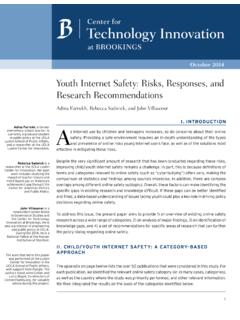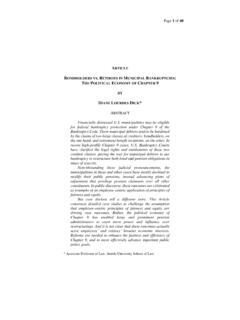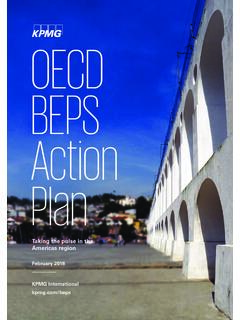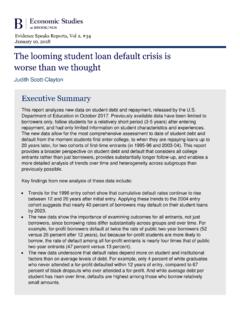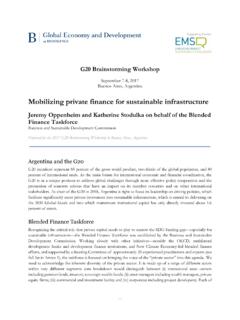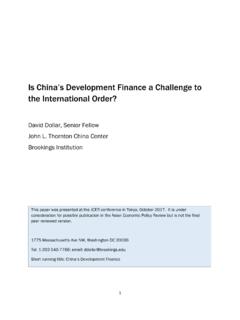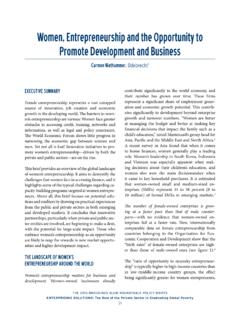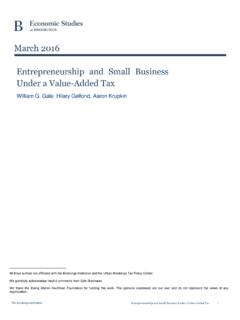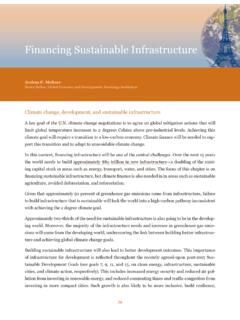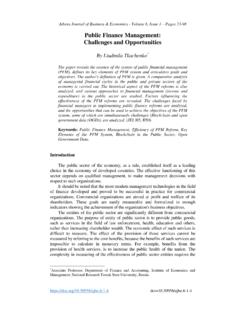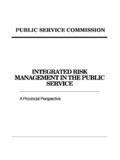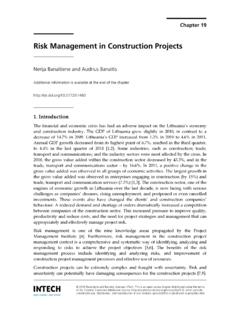Transcription of The Origins of the Financial Crisis - Brookings Institution
1 F I X I N G F I N A N C E S E R I E S P A P E R 3 | N O V E M B E R 2 0 0 8 The Origins of the Financial CrisisMartin Neil Baily, Robert E. Litan, and Matthew S. JohnsonThe Initiative on Business and Public Policy provides analytical research and constructive recommendations on public policy issues affecting the business sector in the United States and around the Origins of the Financial CrisisMartin Neil Baily, Robert E. Litan, and Matthew S. JohnsonThe Initiative on Business and Public Policy provides analytical research and constructive recommendations on public policy issues affecting the business sector in the United States and around the hE OR i g iN S O f T h E f i N a N c i aL c Ri S i S n oV e M Be r 2 0 0 8 ConTenTSSummary 7 Introduction 10housing Demand and the Perception of Low risk in housing Investment 11 The Shifting Composition of Mortgage Lending and the erosion of Lending Standards 1 economic Incentives in the housing and Mortgage origination Markets
2 20 Securitization and the Funding of the housing Boom 22 More Securitization and More Leverage CDos, SIVs, and Short-Term Borrowing 27 Credit Insurance and Tremendous growth in Credit Default Swaps 32 The Credit rating Agencies 3 Federal reserve Policy, Foreign Borrowing and the Search for Yield 36regulation and Supervision 0 The Failure of Company risk management Practices 2 The Impact of Mark to Market 3 Lessons from Studying the Origins of the Crisis references 6 About the Authors 7T hE OR i g iN S O f T h E f i N a N c i aL c Ri S i S n oV e M Be r 2 0 0 8 7 The Financial Crisis that has been wreaking havoc in markets in the and across the world since August 2007 had its Origins in an asset price bubble that interacted with new kinds of Financial
3 Innovations that masked risk; with compa-nies that failed to follow their own risk management procedures; and with regulators and supervisors that failed to restrain excessive risk bubble formed in the housing markets as home prices across the country increased each year from the mid 1990s to 2006, moving out of line with fun-damentals like household income. Like traditional asset price bubbles, expectations of future price increases developed and were a significant factor in inflating house prices. As individuals witnessed rising prices in their neighborhood and across the country, they began to expect those prices to con-tinue to rise, even in the late years of the bubble when it had nearly rapid rise of lending to subprime borrowers helped inflate the housing price bubble.
4 Before 2000, subprime lending was virtually non-existent, but thereafter it took off exponentially. The sus-tained rise in house prices, along with new Financial innovations, suddenly made subprime borrowers previously shut out of the mortgage markets attractive customers for mortgage lenders. Lend-ers devised innovative Adjustable Rate Mortgages (ARMs) with low teaser rates, no down-pay-ments, and some even allowing the borrower to postpone some of the interest due each month and add it to the principal of the loan which were predicated on the expectation that home prices would continue to rise.
5 But innovation in mortgage design alone would not have enabled so many subprime borrowers to access credit without other innovations in the so-called process of securitizing mortgages or the pooling of mortgages into packages and then sell-SUMMArYing securities backed by those packages to inves-tors who receive pro rata payments of principal and interest by the borrowers. The two main govern-ment-sponsored enterprises devoted to mortgage lending, Fannie Mae and Freddie Mac, developed this financing technique in the 1970s, adding their guarantees to these mortgage-backed securities (MBS) to ensure their marketability.
6 For roughly three decades, Fannie and Freddie confined their guarantees to prime borrowers who took out conforming loans, or loans with a principal below a certain dollar threshold and to borrowers with a credit score above a certain limit. Along the way, the private sector developed MBS backed by non-conforming loans that had other means of credit enhancement, but this market stayed relatively small until the late 1990s. In this fashion, Wall Street investors effectively financed homebuyers on Main Street. Banks, thrifts, and a new industry of mortgage brokers originated the loans but did not keep them, which was the old way of financ-ing home ownership.
7 Over the past decade, private sector commercial and investment banks developed new ways of se-curitizing subprime mortgages: by packaging them into Collateralized Debt Obligations (sometimes with other asset-backed securities), and then divid-ing the cash flows into different tranches to ap-peal to different classes of investors with different tolerances for risk. By ordering the rights to the cash flows, the developers of CDOs (and subse-quently other securities built on this model), were able to convince the credit rating agencies to assign their highest ratings to the securities in the high-est tranche, or risk class.
8 In some cases, so-called monoline bond insurers (which had previously concentrated on insuring municipal bonds) sold protection insurance to CDO investors that would pay off in the event that loans went into default. In other cases, especially more recently, insurance companies, investment banks and other parties did T hE OR i g iN S O f T h E f i N a N c i aL c Ri S i S8 T h e I n i t i a t i v e o n B u s i n e s s a n d P u b l i c P o l i c y | T h e B r o o kI n gS I n S T I T U T Io n the near equivalent by selling credit default swaps (CDS)
9 , which were similar to monocline insurance in principle but different in risk, as CDS sellers put up very little capital to back their new innovations enabled Wall Street to do for subprime mortgages what it had already done for conforming mortgages, and they facilitated the boom in subprime lending that occurred after 2000. By channeling funds of institutional investors to support the origination of subprime mortgages, many households previously unable to qualify for mortgage credit became eligible for loans. This new group of eligible borrowers increased housing demand and helped inflate home new Financial innovations thrived in an en-vironment of easy monetary policy by the Fed-eral Reserve and poor regulatory oversight.
10 With interest rates so low and with regulators turning a blind eye, Financial institutions borrowed more and more money ( increased their leverage) to finance their purchases of mortgage-related securi-ties. Banks created off-balance sheet affiliated enti-ties such as Structured Investment Vehicles (SIVs) to purchase mortgage-related assets that were not subject to regulatory capital requirements Finan-cial institutions also turned to short-term collater-alized borrowing like repurchase agreements, so much so that by 2006 investment banks were on average rolling over a quarter of their balance sheet every night.
